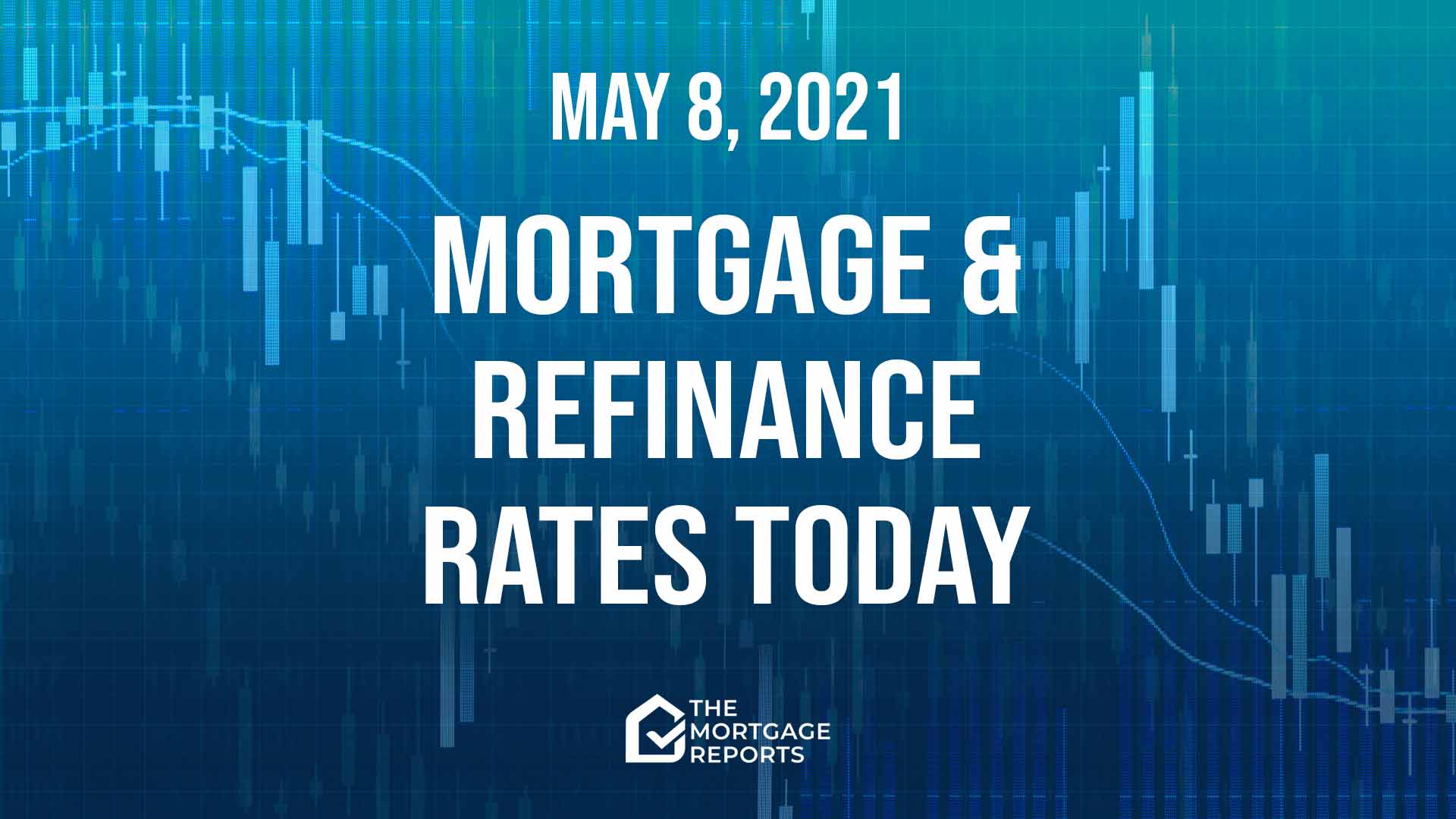
Today’s mortgage and refinance rates
Average mortgage rates tumbled by a worthwhile amount yesterday. We’ll address why later. And discuss the risk that they’ll bounce back quickly.
Mortgage rates next week remain unpredictable. But there’s a real chance of their rising in certain circumstances.
Find and lock a low rate (May 8th, 2021)Current mortgage and refinance rates
| Program | Mortgage Rate | APR* | Change |
|---|---|---|---|
| Conventional 30 year fixed | |||
| Conventional 30 year fixed | 2.978% | 2.983% | -0.01% |
| Conventional 15 year fixed | |||
| Conventional 15 year fixed | 2.188% | 2.305% | -0.06% |
| Conventional 20 year fixed | |||
| Conventional 20 year fixed | 2.75% | 2.842% | Unchanged |
| Conventional 10 year fixed | |||
| Conventional 10 year fixed | 1.815% | 2.007% | -0.08% |
| 30 year fixed FHA | |||
| 30 year fixed FHA | 2.686% | 3.342% | -0.06% |
| 15 year fixed FHA | |||
| 15 year fixed FHA | 2.462% | 3.063% | -0.01% |
| 5 year ARM FHA | |||
| 5 year ARM FHA | 2.5% | 3.201% | Unchanged |
| 30 year fixed VA | |||
| 30 year fixed VA | 2.255% | 2.426% | -0.04% |
| 15 year fixed VA | |||
| 15 year fixed VA | 2.25% | 2.571% | Unchanged |
| 5 year ARM VA | |||
| 5 year ARM VA | 2.5% | 2.379% | Unchanged |
| Rates are provided by our partner network, and may not reflect the market. Your rate might be different. Click here for a personalized rate quote. See our rate assumptions here. | |||
COVID-19 mortgage updates: Mortgage lenders are changing rates and rules due to COVID-19. To see the latest on how coronavirus could impact your home loan, click here.
Should you lock a mortgage rate today?
I would lock my rate today, if I were you. Average mortgage rates are currently at their lowest for well over a month. And they may well not stay that way for long.
But, as always, that’s just one man’s opinion. You could choose to keep floating your rate. And it’s always possible they could fall further. But, in my view, it’s much more likely they’ll rise soon. Read on to discover why I think that.
So my overall recommendations remain:
- LOCK if closing in 7 days
- LOCK if closing in 15 days
- LOCK if closing in 30 days
- LOCK if closing in 45 days
- LOCK if closing in 60 days
However, with so much uncertainty at the moment, your instincts could easily turn out to be as good as mine — or better. So be guided by your gut and your personal tolerance for risk.
What’s moving current mortgage rates
The trigger for yesterday’s relatively sharp fall in mortgage rates was some economic data that came out that morning. It was the government’s monthly employment situation report, often the most influential report of all.
Economists had expected employment to rise by about a million jobs in April. But the actual number was 266,000. In most months, that would be a win. But we’re still recovering from the pandemic. And with nearly 10 million jobs lost as a result of that, we need great numbers to catch up.
When the jobs report was published, markets reacted as you’d expect. Stock indexes fell and bond yields plummeted. But then something weird happened. Both the indexes and the yields quickly recovered. Perhaps alone, mortgage rates remained close to their low point.
Outlier reports happen from time to time. And employment data earlier in the week was good. So investors quickly decided that this was a one-time freak. And resumed business as usual. As a result, yields of 10-year Treasuries, which bottomed out at 1.52% at about 10:30 a.m. (ET), were back up to 1.57% by late afternoon.
Regular readers will know about the close relationship between those yields on 10-year Treasuries and mortgage rates. They don’t march in lockstep. But, over time, those rates normally shadow those yields more closely than you might expect.
So the question is: Will the elastic that’s currently stretched between the two suddenly snap back next week? Nobody can be sure. But it’s a reasonable scenario. And, if it happens, that could make today a unique opportunity to lock at a great rate.
Economic reports next week
It’s quite an interesting week for economic reports. The star is likely to be Friday’s retail sales. But investors are very focused on signs of future inflation at the moment. So they may pay attention to Wednesday’s consumer price index, Thursday’s producer price index and Friday’s import price index.
However, regular readers will know that markets have been ignoring most economic reports in recent weeks. So the effects of the following may be different from usual:
- Tuesday — April’s NFIB small business index
- Wednesday — April consumer price index (CPI), including core CPI
- Thursday — Producer price index for April. Plus weekly new claims for unemployment insurance
- Friday — April retail sales, industrial production and import price index. Plus May consumer sentiment
Will it be an interesting week for mortgage rates? That partly depends on how (and if) investors respond to these reports.
Find and lock a low rate (May 8th, 2021)
Mortgage interest rates forecast for next week
Yes, mortgage rates remain essentially unpredictable. But the scenario I described above in which they snap back following Friday’s fall is a real possibility. That’s why I’d play safe and lock today.
Mortgage and refinance rates usually move in tandem. But note that refinance rates are currently a little higher than those for purchase mortgages. That gap’s likely to remain fairly constant as they change.
Meanwhile, a recent regulatory change has made most mortgages for investment properties and vacation homes more expensive.
How your mortgage interest rate is determined
Mortgage and refinance rates are generally determined by prices in a secondary market (similar to the stock or bond markets) where mortgage-backed securities are traded.
And that’s highly dependent on the economy. So mortgage rates tend to be high when things are going well and low when the economy’s in trouble.
Your part
But you play a big part in determining your own mortgage rate in five ways. You can affect it significantly by:
- Shopping around for your best mortgage rate — They vary widely from lender to lender
- Boosting your credit score — Even a small bump can make a big difference to your rate and payments
- Saving the biggest down payment you can — Lenders like you to have real skin in this game
- Keeping your other borrowing modest — The lower your other monthly commitments, the bigger the mortgage you can afford
- Choosing your mortgage carefully — Are you better off with a conventional, FHA, VA, USDA, jumbo or another loan?
Time spent getting these ducks in a row can see you winning lower rates.
Remember, it’s not just a mortgage rate
Be sure to count all your forthcoming homeownership costs when you’re working out how big a mortgage you can afford. So focus on your “PITI” That’s your Principal (pays down the amount you borrowed), Interest (the price of borrowing), (property) Taxes, and (homeowners) Insurance. Our mortgage calculator can help with these.
Depending on your type of mortgage and the size of your down payment, you may have to pay mortgage insurance, too. And that can easily run into three figures every month.
But there are other potential costs. So you’ll have to pay homeowners association dues if you choose to live somewhere with an HOA. And, wherever you live, you should expect repairs and maintenance costs. There’s no landlord to call when things go wrong!
Finally, you’ll find it hard to forget closing costs. You can see those reflected in the annual percentage rate (APR) you’ll be quoted. Because that effectively spreads them out over your loan’s term, making that higher than your straight mortgage rate.
But you may be able to get help with those closing costs your down payment, especially if you’re a first-time buyer. Read:
Down payment assistance programs in every state for 2021



